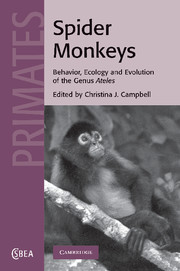Book contents
- Frontmatter
- Contents
- List of contributors
- Acknowledgements
- 1 Introduction
- Part I Taxonomy, phylogeny and evolution
- Part II Ecology
- Part III Behavior and reproduction
- 7 Locomotion and positional behavior of spider monkeys
- 8 Communication in spider monkeys: the function and mechanisms underlying the use of the whinny
- 9 Social interactions, social relationships and the social system of spider monkeys
- 10 Spider monkey reproduction and sexual behavior
- 11 Immaturity in spider monkeys: a risky business
- 12 Demography and group composition of Ateles
- Part IV Interactions with humans
- Index
- References
7 - Locomotion and positional behavior of spider monkeys
Published online by Cambridge University Press: 05 May 2010
- Frontmatter
- Contents
- List of contributors
- Acknowledgements
- 1 Introduction
- Part I Taxonomy, phylogeny and evolution
- Part II Ecology
- Part III Behavior and reproduction
- 7 Locomotion and positional behavior of spider monkeys
- 8 Communication in spider monkeys: the function and mechanisms underlying the use of the whinny
- 9 Social interactions, social relationships and the social system of spider monkeys
- 10 Spider monkey reproduction and sexual behavior
- 11 Immaturity in spider monkeys: a risky business
- 12 Demography and group composition of Ateles
- Part IV Interactions with humans
- Index
- References
Summary
Introduction
Living atelines form a unique group that occupies an important place in the adaptive radiation of New World monkeys. The four (or five) genera, Alouatta, Ateles, Lagothrix (and Oreonax) and Brachyteles, that compose the group are distinguished from other platyrrhines by their relatively large size (c. 5–11 kg), strong inclination to herbivory (fruits and leaves), tail-assisted forelimb-dominated suspensory positional behavior with associated postcranial morphology, and a prehensile tail with a naked ventral grasping surface (Rosenberger and Strier, 1989; Strier, 1992). Although consistent in its phylogenetic unity, atelines are morphologically and behaviorally heterogeneous.
More precisely, howler monkeys, Alouatta spp., appear to have opted for an energy minimizing foraging strategy, feeding on high proportions of leaves through sitting and tail–hindlimb assisted postures, and exploiting small home ranges traveling short daily distances mainly by quadrupedally walking and clambering above branches (Rosenberger and Strier, 1989; Strier, 1992). On the other hand, the rest of the genera, grouped as atelins, appear to share several derived features related to more agile and suspensory locomotor and postural behaviors as well as a more energy maximizing foraging strategy (Rosenberger and Strier, 1989; Strier, 1992). Phylogenetic relationships between these genera have not been established yet, especially under the light of new data deriving from molecular studies (Harada et al., 1995; Schneider et al., 1996; Cavanez et al., 1999; von Dornum and Ruvolo, 1999; Meireles et al., 1999; Collins, 2004).
Information
- Type
- Chapter
- Information
- Spider MonkeysThe Biology, Behavior and Ecology of the Genus Ateles, pp. 185 - 219Publisher: Cambridge University PressPrint publication year: 2008
References
Accessibility standard: Unknown
- 26
- Cited by
